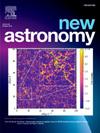Unlocking the hidden potential of pulsar astronomy
IF 2.1
4区 物理与天体物理
Q2 ASTRONOMY & ASTROPHYSICS
引用次数: 0
Abstract
Pulsars have traditionally been used for research into fundamental physics and astronomy. In this paper, we investigate the expanding applications of radio pulsars in societal and industrial domains beyond their conventional scientific roles. We describe emerging applications in positioning, navigation, timing and synchronization, random number generation, space weather monitoring, public engagement, antenna calibration techniques, and leveraging extensive pulsar data sets generated by large-scale observatories. Such pulsar data sets have already been used to demonstrate quantum-computing algorithms.
We evaluate the potential for compact radio receiver systems for pulsar detection by describing optimal observing bands. We show that relatively simple and compact receiver systems can detect the brightest pulsar, Vela. The equivalent of an m-diameter dish with a small bandwidth operating around 700 MHz would be able to detect many more pulsars. Such a detector would be able to localize itself to around 10 km using pulsar navigation techniques.
The space weather community requires direct measurements of the integrated electron density at a range of solar elongations. The only method to get model-independent values is through pulsar observations and we explore the possibility of measuring dispersion measures (DMs) (and rotation measures) with a range of telescopes (observing from low to mid-frequencies) as well as using a typical model to predict the variation of the DM as a function of solar radii. We review how pulsars can be used to produce random sequences and demonstrate that such sequences can be produced using the scintillation properties of pulsars as well as from pulse jitter.
释放脉冲星天文学的潜在潜力
脉冲星传统上被用于基础物理和天文学的研究。在本文中,我们研究了射电脉冲星在社会和工业领域的扩展应用,超出了它们传统的科学作用。我们描述了定位、导航、定时和同步、随机数生成、空间天气监测、公众参与、天线校准技术以及利用大型天文台生成的大量脉冲星数据集的新兴应用。这样的脉冲星数据集已经被用来演示量子计算算法。我们通过描述最佳观测波段来评估用于脉冲星探测的紧凑型无线电接收机系统的潜力。我们展示了相对简单和紧凑的接收器系统可以探测到最亮的脉冲星船帆。相当于直径4米的天线,在700兆赫的小带宽下工作,将能够探测到更多的脉冲星。这样的探测器将能够利用脉冲星导航技术将自身定位在10公里左右。空间气象界需要直接测量太阳延伸范围内的综合电子密度。获得与模型无关的值的唯一方法是通过脉冲星观测,我们探索了用一系列望远镜(从低频到中频观测)测量色散测量(DMs)(和旋转测量)的可能性,以及使用典型模型来预测DM作为太阳半径函数的变化。我们回顾了如何使用脉冲星来产生随机序列,并证明了这种序列可以使用脉冲星的闪烁特性以及脉冲抖动来产生。
本文章由计算机程序翻译,如有差异,请以英文原文为准。
求助全文
约1分钟内获得全文
求助全文
来源期刊

New Astronomy
地学天文-天文与天体物理
CiteScore
4.00
自引率
10.00%
发文量
109
审稿时长
13.6 weeks
期刊介绍:
New Astronomy publishes articles in all fields of astronomy and astrophysics, with a particular focus on computational astronomy: mathematical and astronomy techniques and methodology, simulations, modelling and numerical results and computational techniques in instrumentation.
New Astronomy includes full length research articles and review articles. The journal covers solar, stellar, galactic and extragalactic astronomy and astrophysics. It reports on original research in all wavelength bands, ranging from radio to gamma-ray.
 求助内容:
求助内容: 应助结果提醒方式:
应助结果提醒方式:


